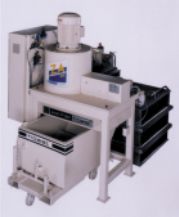E-Archive
Articles
in Vol. 2 - June Issue - Year 2001
Innovative Trowal Finishing Process for Jet Engine Fan Blade Overhaul

Fan-Blades in Process Fixture

Trowal Recycling Centrifuge ZA 04
USF Walther Trowal introduces a surface finishing machine and process technique for simultaneous treatment of several fan-blades in vertical position.
During the refurbishing sequence of a jet engine the large fan blades made of titanium require a cleaning, peening and finishing process prior to being reassembled to the engine.
The surface quality is required to be smooth after the finishing process for utmost airflow performance. Final finishing is done after the shot peening of the blade.
The shot peening process normally produces a uniform surface quality of RMS 40 - 50 (Ra 1.0 - 1.2) which is too rough for a smooth airflow. The surface of a finished fan blade requires about RMS 12 - 16 (Ra 0.3 - 0.4) or better as some aircraft engine manufacturers specify.
The known standard finishing process for fan blades is done in long tub vibrators divided in 2 or 3 chambers where the parts rotate loose in a mass of fine finishing ceramic or porcelain media for several hours. Sometimes finishing powders or pastes are added to the media to speed up the process to reduce cycle times or cover erosion pits in the surface.
The fan blades often show damages at leading or trailing edges when the blade and the hard media touches the tub wall accidentally during the process.
Walther Trowal has conducted many tests on fan blades with the target:
- to reduce processing cycles,
- to avoid damaging of leading and trailing edges, - to increase machine capacity, - to allow the production process to be run automatically, - to reduce processing cost per blade.
The machine features a large tub vibrator combined with a fixturing and lowering device allowing up to 5 fan blades to be finished in a batch. The fan blades leading edges are positioned towards the media roll equally as the airflow will be when blades are in operation on the engine.
The proper positioning and the resistance of the fixtured blades towards the rotating media produces the required finish at the important areas of airflow. The desired surface quality can be controlled by the cycle time.
The average cycle time to achieve RMS 12 - 16 takes 40 min for 5 blades. If RMS 6 - 8 is required the cycle time might be extended to 1 hour.
The Trowal machine V480-S is capable of handling fan blades up to a length of 1100 mm (44") and a blade width of 500 mm (20"). Larger blades of the CF6, Trent 800 etc. engines can only be fixtured and processed in 3 to max. 4 parts per cycle.
Loading and unloading of blades can easily be done manually. The fan blades are fixtured and clamped at the root (dove tail) during the finishing process which limits the handling weight to the blades weight only.
The process is conducted with the newly developed Trowal plastic bonded media V 2030 19 or 24 mm cones producing a smooth surface finish with little material removal. The addition of Trowal compound ARF and water during the entire finishing process cycle will always care for clean fan blade surfaces with
no residue settling in possible erosion pits. The leading and trailing edges do not experience nicks from hard and high
dense ceramic media.
The fan blade finishing machine V 480 - S is completely enclosed in a sound cabinet utilized with sliding access doors to the parts fixturing area and all maintenance spots of the machine.
The noise level is guaranteed < 75 dB(A). Air circulation and illumination of the cabin is incorporated.
If water (effluent) treatment from the finishing process is an issue Walther Trowal offers the process water recycling centrifuges ZM 03 in manual or ZA 04 in automatic sludge removal/peeling version. The effluent is collected by a tank with stirrer and pumped into the centrifuge continuously.
At high centrifugal force of approx. 2000 g the media and metal fines are separated from the processing water and collected in the sludge basket. The processing water blended with compound ARF is then pumped back to the finishing process in the vibrator. Evaporation and loss of liquid carried out by the blades are automatically replaced with fresh water and compound. A close loop processing system with a recycling centrifuge provides an independent installation at any site in the production area.
For Information:
Walther Trowal GmbH&Co.KG
Rheinische Str. 35 - 37
42781 Haan, Germany
Tel.: +49-2129-571-0
Fax: +49-2129-571-225
E-Mail: info@walther-trowal.de




























